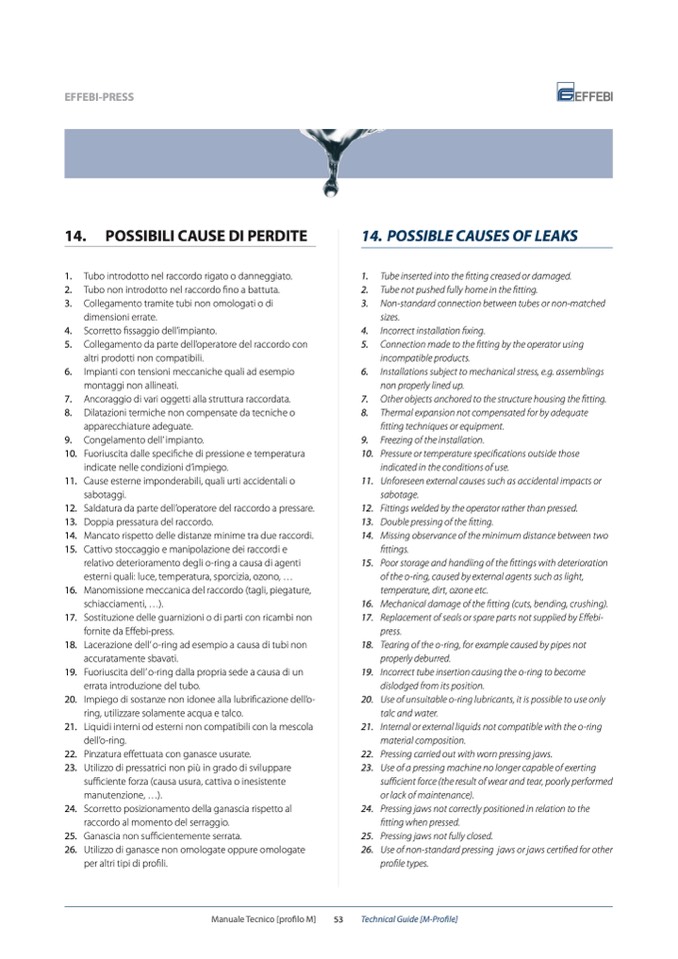
EFFEBI-PRESS
14. POSSIBILI CAUSE DI PERDITE
1. Tubo introdotto nel raccordo rigato o danneggiato.
2. Tubo non introdotto nel raccordo fino a battuta.
3. Collegamento tramite tubi non omologati o di
dimensioni errate.
4. Scorretto fissaggio dell’impianto.
5. Collegamento da parte dell’operatore del raccordo con
altri prodotti non compatibili.
6. Impianti con tensioni meccaniche quali ad esempio
montaggi non allineati.
7. Ancoraggio di vari oggetti alla struttura raccordata.
8. Dilatazioni termiche non compensate da tecniche o
apparecchiature adeguate.
9. Congelamento dell’ impianto.
10. Fuoriuscita dalle specifiche di pressione e temperatura
indicate nelle condizioni d’impiego.
11. Cause esterne imponderabili, quali urti accidentali o
sabotaggi.
12. Saldatura da parte dell’operatore del raccordo a pressare.
13. Doppia pressatura del raccordo.
14. Mancato rispetto delle distanze minime tra due raccordi.
15. Cattivo stoccaggio e manipolazione dei raccordi e
relativo deterioramento degli o-ring a causa di agenti
esterni quali: luce, temperatura, sporcizia, ozono, ...
16. Manomissione meccanica del raccordo (tagli, piegature,
schiacciamenti, ...).
17. Sostituzione delle guarnizioni o di parti con ricambi non
fornite da Effebi-press.
18. Lacerazione dell’ o-ring ad esempio a causa di tubi non
accuratamente sbavati.
19. Fuoriuscita dell’ o-ring dalla propria sede a causa di un
errata introduzione del tubo.
20. Impiego di sostanze non idonee alla lubrificazione dell’o-
ring, utilizzare solamente acqua e talco.
21. Liquidi interni od esterni non compatibili con la mescola
dell’o-ring.
22. Pinzatura effettuata con ganasce usurate.
23. Utilizzo di pressatrici non più in grado di sviluppare
sufficiente forza (causa usura, cattiva o inesistente
manutenzione, ...).
24. Scorretto posizionamento della ganascia rispetto al
raccordo al momento del serraggio.
25. Ganascia non sufficientemente serrata.
26. Utilizzo di ganasce non omologate oppure omologate
per altri tipi di profili.
14. POSSIBLE CAUSES OF LEAKS
1. Tube inserted into the fitting creased or damaged.
2. Tube not pushed fully home in the fitting.
3. Non-standard connection between tubes or non-matched
sizes.
4. Incorrect installation fixing.
5. Connection made to the fitting by the operator using
incompatible products.
6. Installations subject to mechanical stress, e.g. assemblings
non properly lined up.
7. Other objects anchored to the structure housing the fitting.
8. Thermal expansion not compensated for by adequate
fitting techniques or equipment.
9. Freezing of the installation.
10. Pressure or temperature specifications outside those
indicated in the conditions of use.
11. Unforeseen external causes such as accidental impacts or
sabotage.
12. Fittings welded by the operator rather than pressed.
13. Double pressing of the fitting.
14. Missing observance of the minimum distance between two
fittings.
15. Poor storage and handling of the fittings with deterioration
of the o-ring, caused by external agents such as light,
temperature, dirt, ozone etc.
16. Mechanical damage of the fitting (cuts, bending, crushing).
17. Replacement of seals or spare parts not supplied by Effebi-
press.
18. Tearing of the o-ring, for example caused by pipes not
properly deburred.
19. Incorrect tube insertion causing the o-ring to become
dislodged from its position.
20. Use of unsuitable o-ring lubricants, it is possible to use only
talc and water.
21. Internal or external liquids not compatible with the o-ring
material composition.
22. Pressing carried out with worn pressing jaws.
23. Use of a pressing machine no longer capable of exerting
sufficient force (the result of wear and tear, poorly performed
or lack of maintenance).
24. Pressing jaws not correctly positioned in relation to the
fitting when pressed.
25. Pressing jaws not fully closed.
26. Use of non-standard pressing jaws or jaws certified for other
profile types.
Manuale Tecnico [profilo M]
53
Technical Guide [M-Profile]

